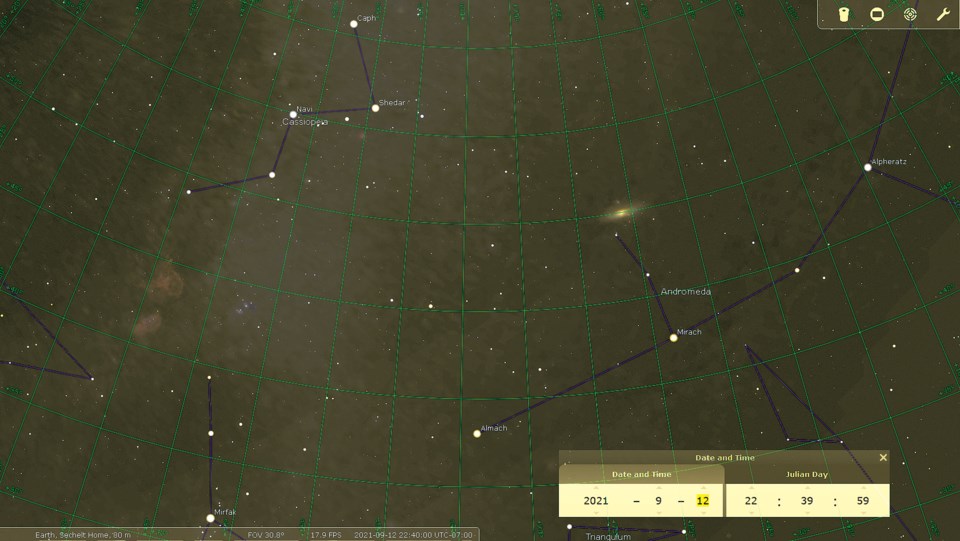We have limited planetary action for September. Saturn and Jupiter are past their August opposition so they rise earlier and are still prominent and great telescope targets. All the other planets are too close to the Sun and/or horizon at sunset for good viewing. The Moon passes above Venus just after sunset on Sept. 9 and passes about 4 degrees below Saturn and Jupiter, respectively, after sunset on Sept. 16 and 17. Other than that, nothing spectacular seems likely: no meteor showers, eclipses or comets coming up. So, let’s look a bit farther afield.
About the year 964, a Persian astronomer was apparently the first to describe a “nebulous smear” in the constellation of Andromeda. This was pre-telescope days so he was describing a naked-eye object.
Curiously, there are two somewhat similar naked-eye objects in southern skies that are much brighter – the Magellanic Clouds – and which the Polynesians absolutely had to have known about a thousand years before Magellan made his notes. It just proves that he who publishes first gets all the credit.
The nebula in Andromeda received lots of attention after the invention of the telescope around 1610 and a number of heavy hitters like Charles Messier and William Herschel (among many) published findings and theories about it. The whole debate over the nature of the “nebula” between Harlow Shapley and Heber Curtis seems to have been (mostly and reasonably accurately) settled by Edwin Hubble, who determined that observation of Cepheid variable stars within Andromeda proved it was at least 10 times farther away than anything else to be seen in our Milky Way galaxy. Voila, and the Andromeda nebula was now the Andromeda Galaxy, one very similar to our own.
Anyway, if the Persian astronomer could see the thing naked-eye a thousand years ago, can we? Absolutely. The fall is the best time to see it and the first half of September is excellent after the Moon sets.
First, find the constellation Cassiopeia, the big “W” about 45 degrees above the horizon in the northeast. The right-hand “V” of three stars – Navi, Shedar and Caph – is pointier and a little brighter than the left-hand one, so follow the “point” on the right, Shedar, down and to the right about 20 degrees (two fist-widths) to a long arc of stars that curve up and to the right.
The one we want is the second one from the left end, named Mirach. From here binoculars are a help. Find Mirach and look up and a bit left about one field-of-view and you should see another not-as-bright star. Do the same thing again from that one and you should see another not-as bright star at about 10 o’clock and a faint patch of light just above and to the right. Congratulations! You are now looking at another galaxy. Practice with the binoculars a few times to get a feel for the place then try to do it naked-eye. After a dozen or so practice runs, it’ll be almost automatic and you too can amaze your friends.
So, our best information on the Andromeda Galaxy is: it is likely the same size or a bit bigger than the Milky Way and roughly the same mass. It is about 2.5 million light-years distant, which means the light we see coming from it left before our species evolved. It is moving toward us at about 110 km/sec and will likely collide with the Milky Way in about five billion years. It also has a couple of smaller satellite galaxies that orbit it, similar to the Milky Way and the Magellanic Clouds which are small irregular satellite galaxies. A truly gorgeous composite of the Andromeda Galaxy and our Moon – to the same scale – can be found on the Astronomy Picture of the Day site archive for Sept. 25, 2020.
The Andromeda Galaxy is pretty much the most distant thing routinely visible to the human eye. Under perfect conditions there are a few farther things barely visible, but they’re rarely seen. I find it remarkably settling to find it in the sky and wonder about it and all its possibilities before going to bed. Amidst pandemics and politics, that helps me remember just how important we all aren’t.
Remember, all of the movements of moon and planets described can be checked out on the web at: heavens-above.com. There will be no regular meeting of the Astronomy Club in September. Information updates may be found at the club website at: sunshinecoastastronomy.wordpress.com.



